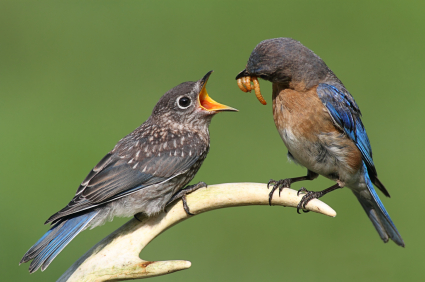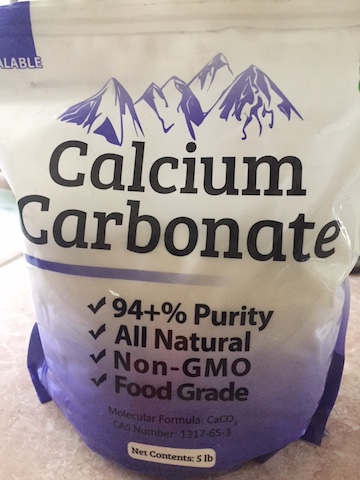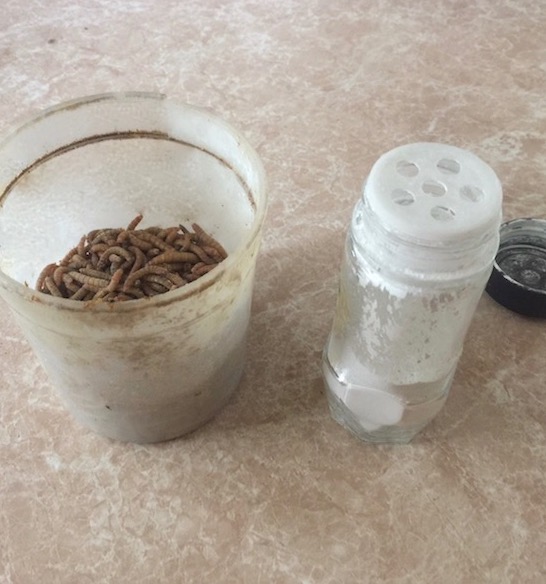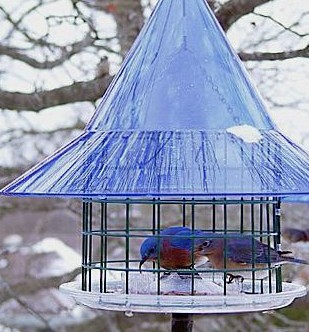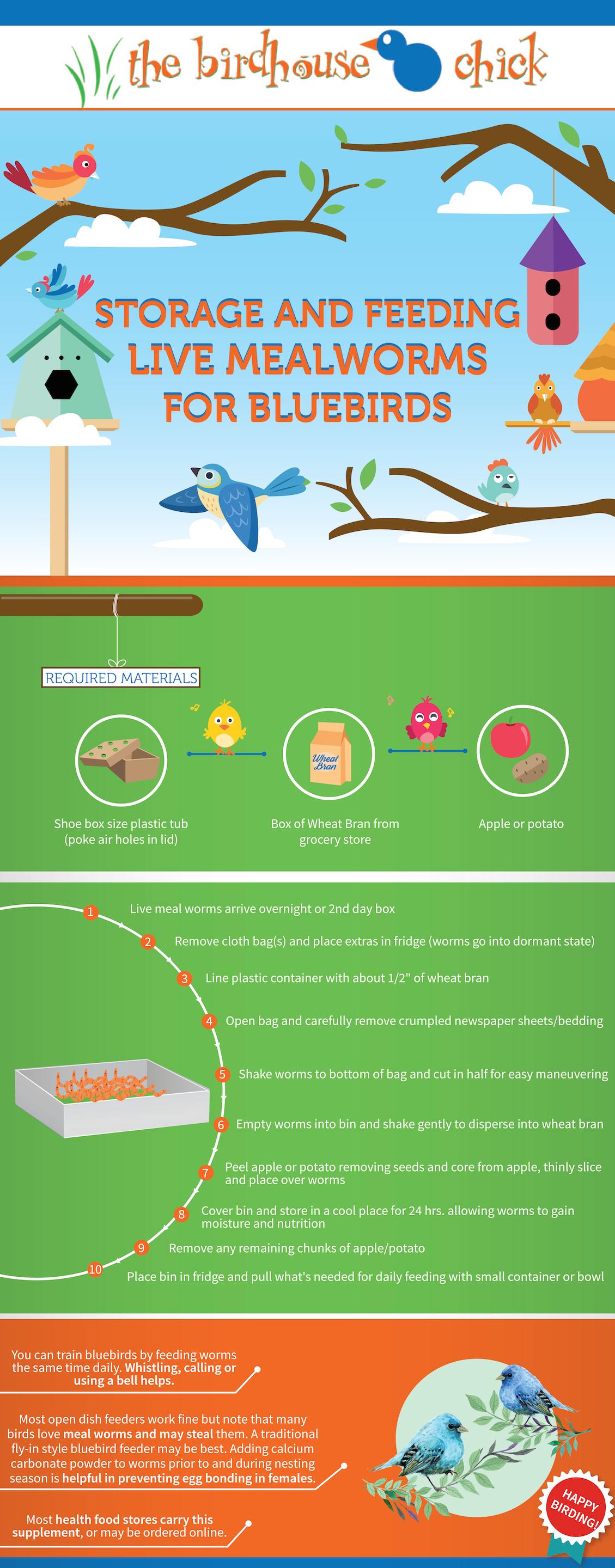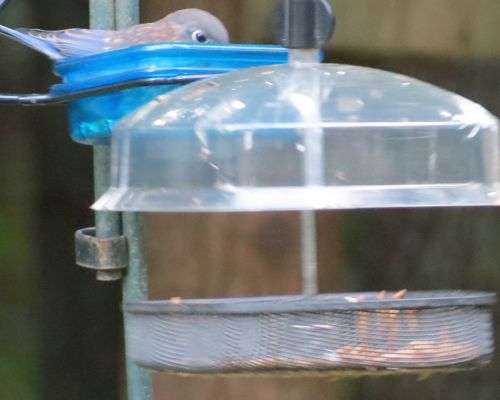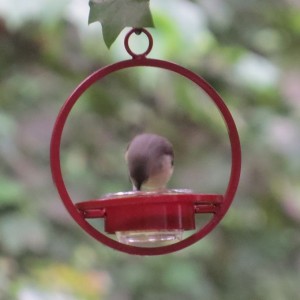-
Easiest Way to Add Calcium to Meal Worms
Sure you can save your egg shells, then you can sterilize the egg shells, then you can crush the egg shells and them to bird food, suet or mealworms. Or you can save a ton of time and shake-shake calcium powder right into meal worms just prior to feeding.
Some birds will actually eat the shells straight-up when sprinkled on a deck rail or on the ground below bird feeders. And some adult birds are known to eat their hatchlings’ shells as a means of keeping the nest clean and gaining calcium.
Why add calcium to meal worms?
So you’re trying/or have finally attracted bluebirds to you yard, Maybe you’re lucky enough have them stick around all year? Feeding lots of mealworms is calcium-depleting because they’re so high in protein. Similar to a sugar overdose for kids, too many worms can be too much of a good thing for bluebirds and others. We’re guilty on this charge!Babies need strong bones to form properly, it’s critical for first flight. Lack of calcium (via parents feeding a disproportionate amount worms vs. natural food like insects or berries) can contribute to deformities. In breeding females, lack of calcium may cause her eggs to form with thin or weak shells. This makes passing the soft eggs difficult and exhausting- sometimes even fatal. Called egg bonding, it can also happen in nature to birds who’ve never eaten from mealworm feeders.
What’s the easiest way to add calcium?
A simple “shake-shake” from a spice jar does it! Calcium carbonate is a powder supplement readily available at most health food stores and online. Fairly inexpensive, one pound will likely last for a few years. Save one of your spice bottles and clean thoroughly.Fill the jar with powder and store the bag for future use. Two shakes into the worms and toss gently to lightly coat/dust the worms. That’s all there is to ensuring your bluebirds are getting enough calcium!
-
Put Some Live Ones in that Mealworm Feeder
So you’ve put up the house, but no bluebirds. Then you try every conceivable bluebird treat on the planet, but still no blues. You know they’re in the area, the color and song are unmistakable. So why aren’t they coming to your place?
Habitat is, and will always be a key factor when trying to entice feathered friends. Bluebirds do prefer open spaces, with perching spots from where they can swoop and hunt insects. Fresh water in a birdbath (a consistent and clean source) is a big one. Birds who may not use feeders still require water. Shelter and cover (evergreens, trees & shrubs) are very important for protection from predators and the elements. Food is the other key part, and if you want bluebirds, it may take their very favorite… live mealworms!
You can finally attract bluebirds and keep them coming back by offering live worms. Creepy, crawly? Maybe just a little at first, but ya get used to it fast 🙂 Handling and storing live worms is simple! The graphic below shows what to do when they arrive and how to keep them fat and happy.
Mealworm feeders range from open dish-style, fly-ins and covered tray-types, to the small kitchen bowl on your deck rail, clay saucer on the porch, and even a plastic container tacked to a tree! Fancy feeder not required… just some improvisation. And we promise, the bluebirds don’t really care as long as worms are easily accessible for them (and not every other bird in the yard). Yes, mealies are extremely popular with many of the backyard avian crews! Should you discover too many other birds stealing worms, a caged or fly-in type feeder may be better suited. But if you’re a little bird-crazy like us… then everybody gets some worms 🙂
-
Opportunistic Robins and More Wait Below this Mealworm Feeder
The worms crawl in-the worms crawl out… of some mealworm feeders!
See them in the back, on the right side? Escapees! It’s problematic enough when cat birds and cardinals and warblers start in on your live worms, after all-they’re meant for the bluebirds. Recent fledges are learning to use the feeders, so it’s a real bummer when they figure it out and it’s empty 🙁
Robins, chipping sparrows, cardinals, towhees, chickadees, titmice and still others have learned that sometimes it rains worms. They’ll sit below this screened mealworm feeder and wait for the manna to fall… and it does.
Not to say the design is sub-par, just maybe not the best choice for offering live mealies. Dried worms and other bluebird treats are ideal in this hanging feeder, but the tooth (screen texture) gives the live ones a good grip and path to exit stage left!
The new steel Orb Feeder features an acrylic cup, a nice smooth surface that keeps worms put, that is until titmice and chickadees discover them. And the blue dish shown above is also a nice smooth surface, one from where worms can not escape.
Something we’ve experimented with this season (and is quite successful) is offering more of the dried worms – much more economical. But the trick is to soften them first so that parents will feed them babies. Steeping dried meal worms in boiling water for about ten minutes-then draining, is ideal if you’re a backyard bird freak like us 🙂
So a good basic rule of thumb is that live worms do much better when placed on a smooth surface! Should too many worms be disappearing altogether, an enclosed feeder is likely best. Bluebirds are one of the few who will “fly-in” a feeder. Without fail, Carolina wrens are always the first to figure it out!
With so many new fledges out and about, it’s a great time to try offering mealworms if you never have in the past. One way to stretch worms and make them lat longer is to use a mixture. One of our recipes includes a no-melt suet cake (crumbled), shelled peanuts and a few sunflower hearts… the birds love it!

